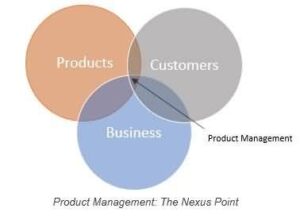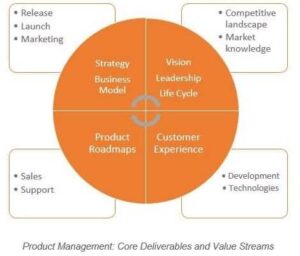
Hiring the Ideal Product Management Executive
A company’s Product Management function — which straddles the oftentimes broad chasm between engineering-driven Product Development and customer-oriented Marketing and Sales organizations — requires a leader who understands the priorities on each side of the divide and knows how to reconcile and prioritize these so that all parties are satisfied and, more importantly, that the company’s strategic objectives are met. To be sure, the need for such cross-functional leadership skills (i.e., the ability to foster and leverage the talents and capabilities of various parts of the organization) is not unique to Product Management. For example, leaders of Continuous Improvement, Accounting, and Human Resources must also encourage and build on the cooperation and input of other company departments in order to fulfill their own missions. However, unlike these squarely inward-facing functions, which are usually categorized as overhead, Product Management typically carries P&L (profit and loss) responsibility and, as such, must focus both on internal capabilities and external market requirements, as well as develop and deploy strategies that ensure that the former optimally serve the latter.
Role of Product Management
First introduced by Proctor and Gamble in the early 1930s and later repurposed and expanded in the 1980s by Microsoft and other high-tech giants, Product Management is now a core business function in almost all non-service businesses. Having expanded beyond its roots in packaged-goods brand and category management, today Product Management is practiced by companies in business sectors as diverse as B2B and consumer products manufacturing, software development, and hardware assembly. What’s more, it is often among the most important drivers behind a company’s growth and profitability. Indeed, in many companies — particularly technology companies — the Product Management function is at the very heart of the revenue-generation engine, since, as its name implies, its charter includes defining products, bringing them to market, and actively monitoring and managing them once they are in-market. More specifically, the function is charged with managing the company’s product portfolio and product life cycle, from new product definition, development, and introduction through maturity, harvest, obsolescence, and replacement.

Product Management: The Nexus Point
In order to carry out its mission, Product Management must act as a unifying hub for the Product Development, Marketing, and Sales functions and serve as a summing node — a central synthesis and resolution point — for product-related internal, customer, and market information. Consequently, its core set of responsibilities is as diverse as it is deep. For example, Product Management must collect market research and customer insight data, define product requirements, determine capability tradeoffs, develop positioning and value propositions, and draw product roadmaps — all of which will likely have short- and long-term implications for a company’s financial forecast, its growth plans and hiring projections, and even its acquisition strategy. When all is said and done, this means that Product Management is responsible for painting a picture of the company’s future. This is why the head of Product Management is sometimes referred to as the CEO of Products—a weighty and appropriate title, as there is little more important to a company’s ongoing success than its products.
Product Management Leaders — Their Titles, Responsibilities, & Organizations
As with many core business functions, the structure of a business’s Product Management function is closely tied to the company’s overall size and the nature of its business. As such, Product Management departments can range from a single individual in a small, one-product firm to hundreds of individuals in a moderately sized high-tech manufacturer to literally thousands of professionals in a global consumer packaged goods maker.
In a large company, the Chief Product Officer (CPO) typically reports directly to the CEO and is ultimately responsible for all product activities, and he or she designs or refines the overall product strategy to align with the corporate vision and to enable the achievement of goals set by the CEO and board of directors.
In mid-sized companies, the Product Management function might be led by a senior-level product leader — such as a senior vice president or simply a vice president of Product Management who reports to a C-level executive and leads a large team of product managers. He or she is responsible for major initiatives that have the potential to create great value for the business, works to achieve alignment among the cross-functional teams (i.e., Product Development, Marketing, and Sales) that are critical to product success, and has input into the company strategy. Such an individual’s direct reports will typically include product managers, and, in companies that adhere to the Agile product develop methodology, product owners. The vice president of Product Marketing is directly responsible for defining product strategy and features, approving product releases, and monitoring product life cycles to ensure maximum payback on product investment.
In the smallest companies, the head of Product Development might also be in charge of Product Management and, in some cases, even of Product Marketing. This is not an ideal scenario as few individuals possess the combination of skills and temperament necessary to fulfill the responsibilities of both roles nor will he or she have the time to dedicate the degree of attention that each warrants.
A Product Management Leader’s Primary Responsibilities
The head of the Product Management function and his or her team have allegiances to three distinct entities — the products, the customers, and the business itself.
The products are the team’s raison d’être, the offspring whom they have shepherded through Product Development, whose character (i.e., feature and benefit set) they have formed, and whose entrance into and progression through life (i.e., the marketplace) they must facilitate and oversee. The customers are a key focus because it is their input — gathered through surveys, web analytics, firsthand interviews, focus groups, and the like — that has informed and shaped the product and that will determine its evolution over its life cycle. Of course, the business itself is a principal stakeholder because it is the entity to which Product Management is accountable for the fulfillment of its primary mission: optimizing products to maximize their ROI (return on investment) and value.
To fulfill its core mission, the Product Management team must have a thorough understanding of the customer’s needs, the Product Development team’s capabilities, and the company’s overall business strategy. It must become immersed in the customer’s requirements to the point of being able to write “use stories,” must be able to justify the deployment of scarce Product Development resources, and has to understand the cost-benefit tradeoffs necessary for the product to fill marketplace needs as well as meet the company’s financial requirements.
Consequently, the Product Management leader and his or her team have multiple loyalties and must be adept at balancing the priorities of and the deliverables expected by their various constituencies. However, all of this notwithstanding, their deepest loyalty needs to be to their products, for which they must have an unflagging passion and on whose behalf they must tirelessly advocate as they are the vessel by which their obligations to all three of their constituencies will be fulfilled.
What Makes a Great Product Management Leader and How Can I Find One?
Selecting the right executive to lead any mission-critical function is not a simple task, but the challenge is compounded when it comes to Product Management. This is because the best Product Management leaders typically have experience in both “Business Development/Marketing/Sales” and Product Development ends of business. This last point is especially important in technology and engineering-driven companies that adhere to the Agile Product Development philosophy, which specifies close interaction between Product Management and Product Development, a situation wherein it is usually easier for the Product Management leader to make sound business decisions if he or she has a more than passing understanding of the technology stack and the capabilities of the Product Development team.

Product Management: Core Deliverables and Value Streams
Given the breadth of the Product Management leader’s responsibilities, he or she must be a visionary as well as a realist and ideally should have a strong right-brain and left-brain orientation, a capacity for the quantitative and the qualitative, and a creative yet analytical perspective. It takes a multi-talented and broadly skilled individual to fill such a role, one who has had experience in both Product Development and Marketing, and who has demonstrated the ability to develop a product portfolio that serves as a solid foundation for ongoing growth rather than, as can all too easily happen, one that turns out to be a flimsy house of cards.
Searching for such a leader is a little like looking for a needle in a haystack or the proverbial pot of gold at the end of a rainbow. Some of the turns in this potentially long and winding road can be evaded if one has access to talent acquisition professionals who employ comprehensive and consistent processes – for example, broad passive candidate research, competency-based behavioral interviewing, and a repeatable candidate identification, selection, and onboarding protocol, such as the Torch Group’s Signature Search ProcessTM.
Even though finding a candidate who is ideally suited to your organization’s culture and has the requisite skills and experience to meet its core business objectives is a tall order, it is not an unrealistic one. As with many of life’s more crucial undertakings, it simply requires a clear understanding of the task at hand, a vision of the desired outcome, and, perhaps, a little expert help along the way. After all, when it comes down to finding the individual who will be charged with ensuring the viability of your company’s current and future products, it doesn’t hurt to take every reasonable measure to ensure that the search process results in the best possible outcome — a perfect fit.
This is the fourth in a series of articles that examines the characteristics and experience that employers should expect to find in candidates for executive and senior leadership positions in mission-critical functions such as marketing communications, business development, digital marketing, product marketing, product management, loyalty marketing, direct marketing, and public relations, as well as sales and other types of channel management.
For comments or for more information, please contact:
Customer and prospect contact: Ronald S. Torch, Founder, Chief Executive Officer, and President, the Torch Group, rontorch@torchgroup.com, www.torchgroup.com, 440.519.1822 x101.
Media contact: Ronald-Stéphane Gilbért, Senior Consultant & Global Managing Director, Gilbért, Flossmann & Zhang Worldwide, rgilbert@globalmarcomm.com, www.globalmarcomm.com, 216.816.4947